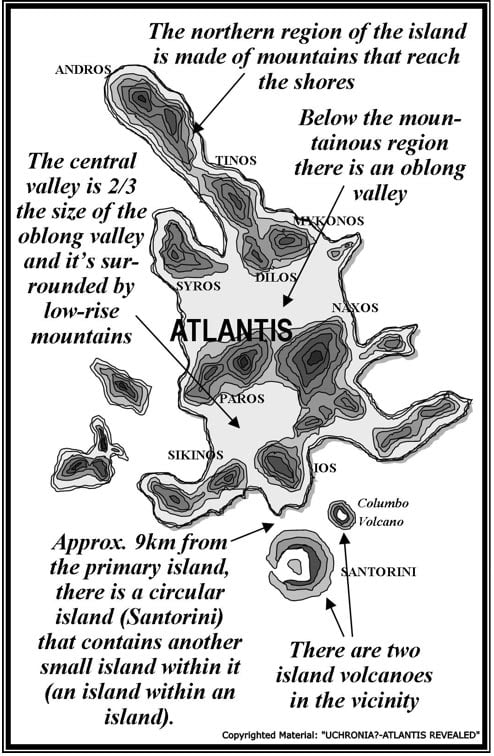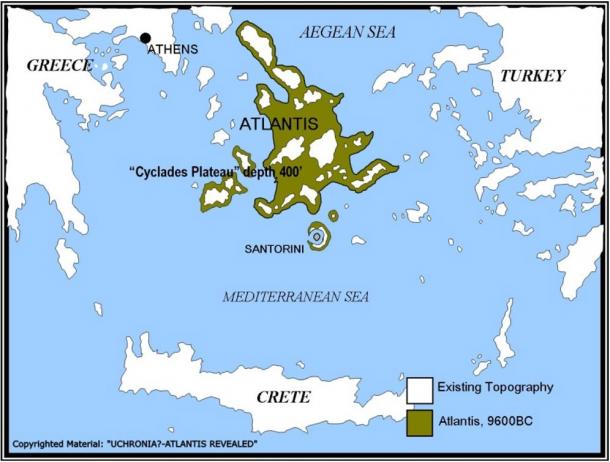The time is 360 BC, the dawn of Western civilization. Athens, the cradle of democracy, is the epicenter of the ancient world. In his dialogues of Timaeus and Critias, Plato introduces a tale of an advanced prehistoric civilization, which since has captivated the imagination of every generation that followed. This was the story of Atlantis, an idyllic island paradise of skillful navigators who often crossed the Atlantic to explore. Atlantis, according to Plato, was ultimately lost to the sea. Its memory, though, was not soon forgotten.
For two millennia, people unsuccessfully kept on searching for the legendary island, making Atlantis one of the most lasting and fascinating stories of all time! What about those, however, who over time claim to have found the lost island? The truth is, no one until now was able to introduce a site that perfectly matched Plato’s description. Instead, we have theories upon theories on the whereabouts of Atlantis. Why though? If everyone utilizes the same textbook, why the apparent confusion? Can this be a case of gross misinterpretation among researchers, or did early translators fail to properly capture and relay Plato’s account? And, what about the chronological conflict that exists in Plato’s account?
Let’s take the original Santorini hypothesis, for example. Unquestionably, the island of Santorini, its volcanic eruption and the advanced Minoan civilization, was the best we had on Atlantis until recently. This was never a flawless hypothesis, though. Always a big problem with that theory was the fact that Plato’s given chronology of 9600 BC had to be discarded (as Athens and most story details did not belong in that
 The Lost Empire of Atl...
Best Price: $2.00
Buy New $11.98
(as of 09:15 UTC - Details)
period). There is another bigger problem with that theory, though. While Santorini itself undeniably matches the site where the crown city of Atlantis once stood (talking about the concentric rings of earth and water) the problem is, Santorini alone never matched Plato’s entire description. The primary island of Atlantis, one Plato said was to be 9 kilometers away, is missing from the particular setting of 1600 BC. These major flaws allowed for critics to raise doubts on that hypothesis, and to continue to question the validity of Plato’s story.
The Lost Empire of Atl...
Best Price: $2.00
Buy New $11.98
(as of 09:15 UTC - Details)
period). There is another bigger problem with that theory, though. While Santorini itself undeniably matches the site where the crown city of Atlantis once stood (talking about the concentric rings of earth and water) the problem is, Santorini alone never matched Plato’s entire description. The primary island of Atlantis, one Plato said was to be 9 kilometers away, is missing from the particular setting of 1600 BC. These major flaws allowed for critics to raise doubts on that hypothesis, and to continue to question the validity of Plato’s story.
Of course, serious research on Atlantis was never simple. Science fiction authors, movies and other creative works of popular culture, eventually capitalized on the story’s popularity, and contrary to Plato’s account, over time they turned Atlantis into an ultra-modern society with flying machines and technology far beyond our own.
 Ancient Greece: From P...
Best Price: $5.50
Buy New $5.95
(as of 05:20 UTC - Details)
Ancient Greece: From P...
Best Price: $5.50
Buy New $5.95
(as of 05:20 UTC - Details)
Nonetheless, eventually every search comes to an end. Recently, a four year study that included a thorough analysis of Plato’s work established that serious errors by early translators allowed for the mixed messages in the translated document.
The recent study not only decisively placed Atlantis in the Mediterranean Sea, but, it concluded with the discovery and identification of a submerged prehistoric island that in every way matches Plato’s Atlantis. While in the past finding Atlantis was thought to be more difficult than winning the lottery, now there is a tangible site where all the physical characteristics of the given description match. The topography, the given chronology, the volcanic geology, the flora and fauna in that period, the island’s destruction by a great flood, the presence of an
 Gobekli Tepe: Genesis ...
Best Price: $11.99
Buy New $12.00
(as of 10:10 UTC - Details)
unknown prehistoric civilization in the area, and DNA evidence all point to a genuine discovery.
Gobekli Tepe: Genesis ...
Best Price: $11.99
Buy New $12.00
(as of 10:10 UTC - Details)
unknown prehistoric civilization in the area, and DNA evidence all point to a genuine discovery.
More specifically, the study shows that around 9600 BC, when according to Plato Atlantis was above water, the modern Cyclades Islands were connected by the Cyclades Plateau, a flat terrain (now 400 feet below sea level,) that formed the body of a huge island. When this prehistoric island is compared to Plato’s Atlantis, it immediately becomes evident that this must have been the land Plato was talking about. Its northern region was comprised of mountains that reached the shores. Below the mountainous region there was an oblong valley measuring 555 Km2. Below the oblong valley there was a smaller valley, 2/3 the size of the oblong valley that measured 370 Km2. This was the primary island. Nine kilometers away from the primary island, and precisely as Plato depicted, lies the island of Santorini, a circular island with a flooded core and a small island in its center (Santorini, an island within an island setting, a sea volcano with a collapsed center, prior to the volcanic eruption of 1600 BC had a single opening on its outer ring that allowed ships to enter its watery caldera).

Plato’s Atlantis

Atlantis area map
The consequence in finding Atlantis at around 9600 BC leaves no doubt that Plato based his story on a real setting and a prehistoric civilization known to ancient Greeks, which in order to successfully communicate some of his philosophical ideas (divine vs. human, ideal societies vs. corrupt,) he filled with familiar matter from later times, including details from the Minoan era of which he was more familiar with. The existence of a matching site at around 9600 BC, in essence, proves that Plato did exactly what Homer did with Troy 400 years before him. (Homer’s Iliad was an entirely fictional story that revolved around a real setting and a historical incident that took place 600 years before Homer himself.)





